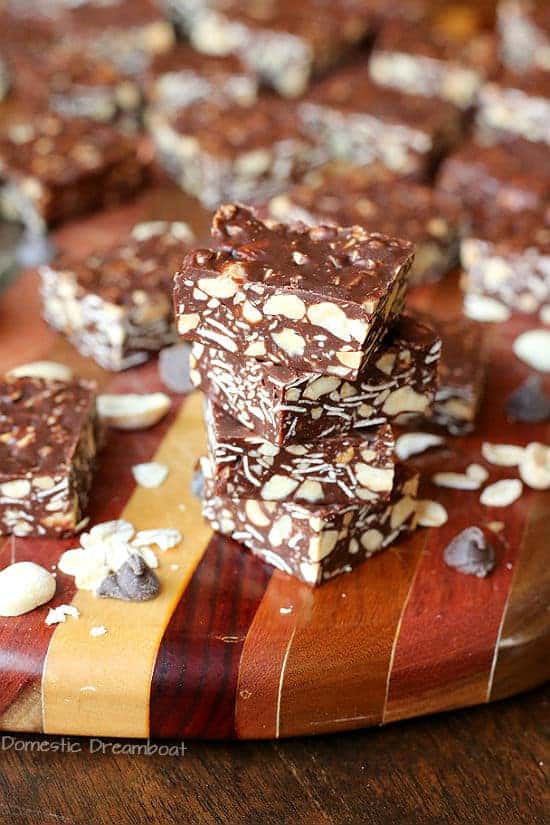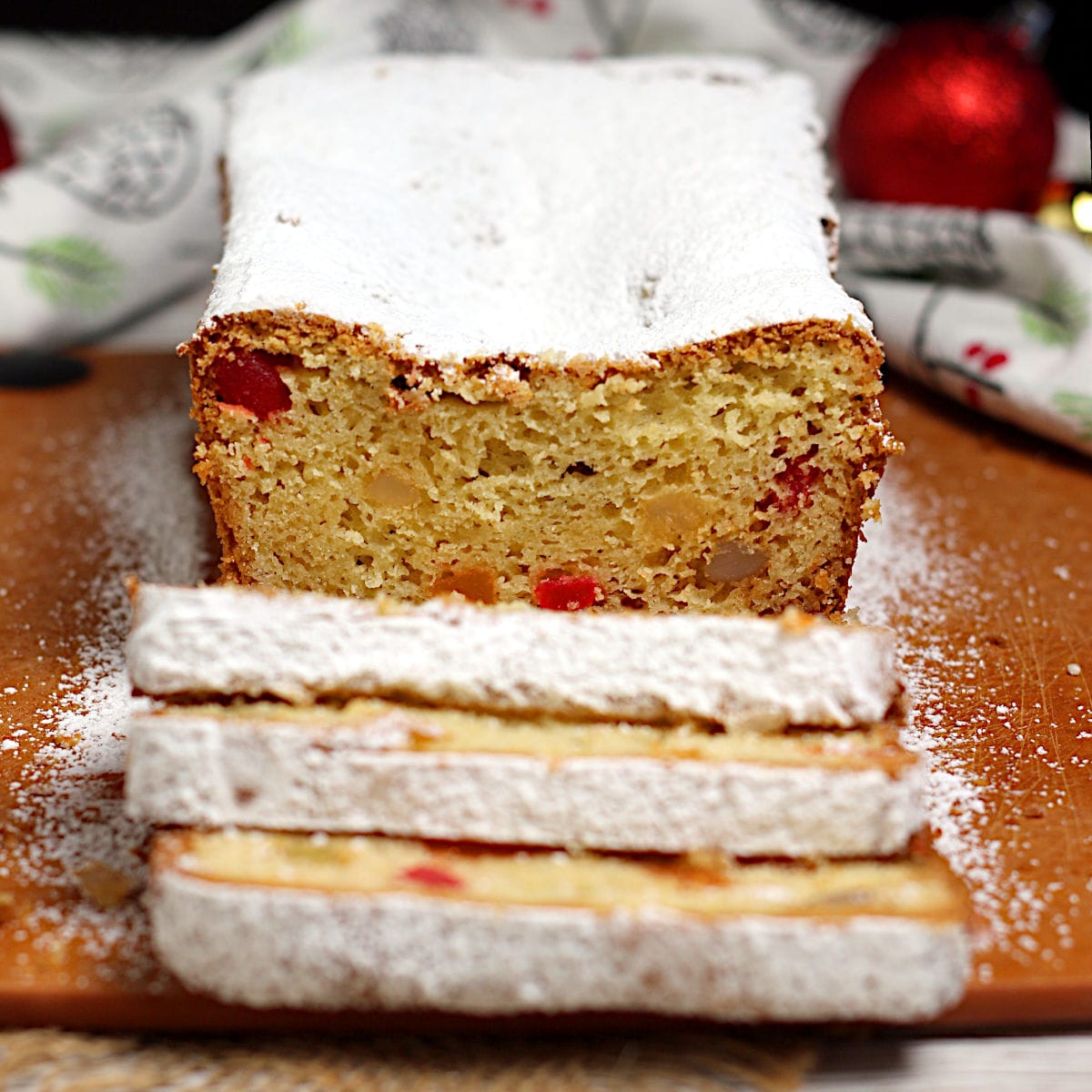Gumdrop Loaf Cake
Gumdrop Loaf Cake is a festive, fun, and colorful cake from the East Coast of Canada that’s commonly served during the holidays.
Today’s recipe comes from the East Coast of Canada. This festive cake is now made all over the Maritimes, often during the holidays, but it originated in Newfoundland.
Gumdrop Loaf Cake features a dense, buttery cake with pieces of gumdrops suspended throughout. Its colorful appearance and fruity flavor make it fun to look at and delicious to eat.
I got this recipe in the form of what I call a “Grandma recipe”, in which I mean it was hand-written, with only very loose instructions. While the recipe was fully legible (I can’t say the same about the recipes from my own Grandma), the first time I made it, it was a disaster.
The cake took forever to cook, and never really did set properly, and the gumdrops all sank to the bottom of the pan. The result was a greasy cake with a deeply sunken, undercooked center, and a solid layer of gumdrops at the bottom.
However, I wasn’t discouraged. Since the cake tasted pretty good still, I decided to try again the next day with a few minor changes to the cooking method, and had much more success.
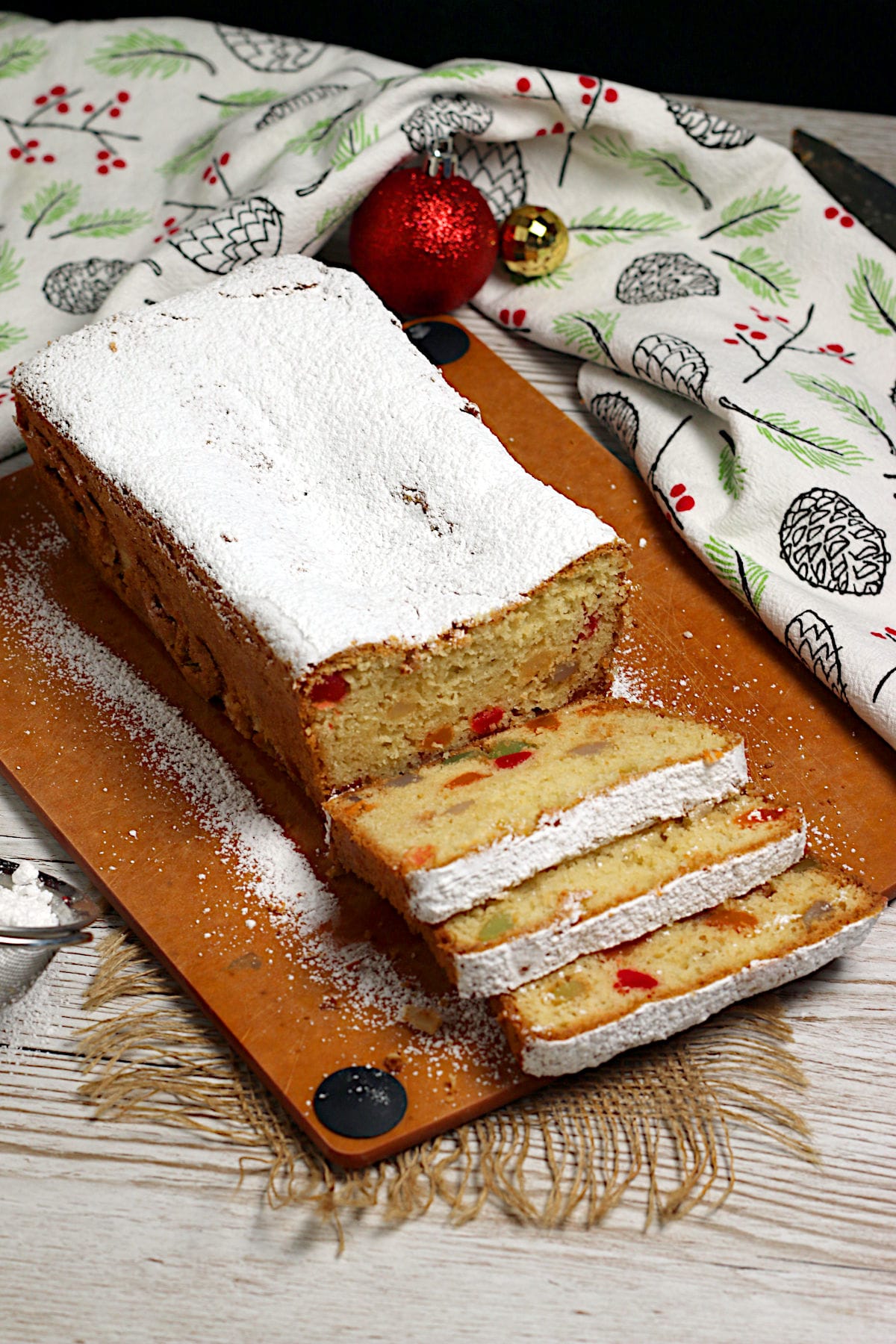
How to Make Gumdrop Loaf Cake
The first step to making this colorful cake is prepping the gumdrops. If you use baking gums, minimal prep will be required since they don’t need to be cut up. Any full-sized gumdrops or jujubes that you might use need to be cut up much smaller. I recommend cutting them into 5-6 pieces each.
Next, toss the gumdrops with some flour (you need to do this with both cut-up and whole baking gums). This helps prevent the cut ones from sticking together, but also helps to prevent them from sinking into the batter during baking.
Now start making the batter. First, mix the dry ingredients (flour, baking powder, baking soda, salt) together in a medium bowl. Set this aside and cream the butter and sugar together using your stand mixer or hand mixer. Add the cream cheese and mix again until light and fluffy. Add the eggs, one at a time, and beat, scraping down the sides of the bowl between each addition. Mix in the lemon juice and vanilla.
Add the flour mixture and mix on low speed until most of the flour is incorporated. Increase the mixer to medium and mix for about a minute. Fold in the gumdrop pieces and any remaining flour with them, gently mixing until no more flour streaks remain.
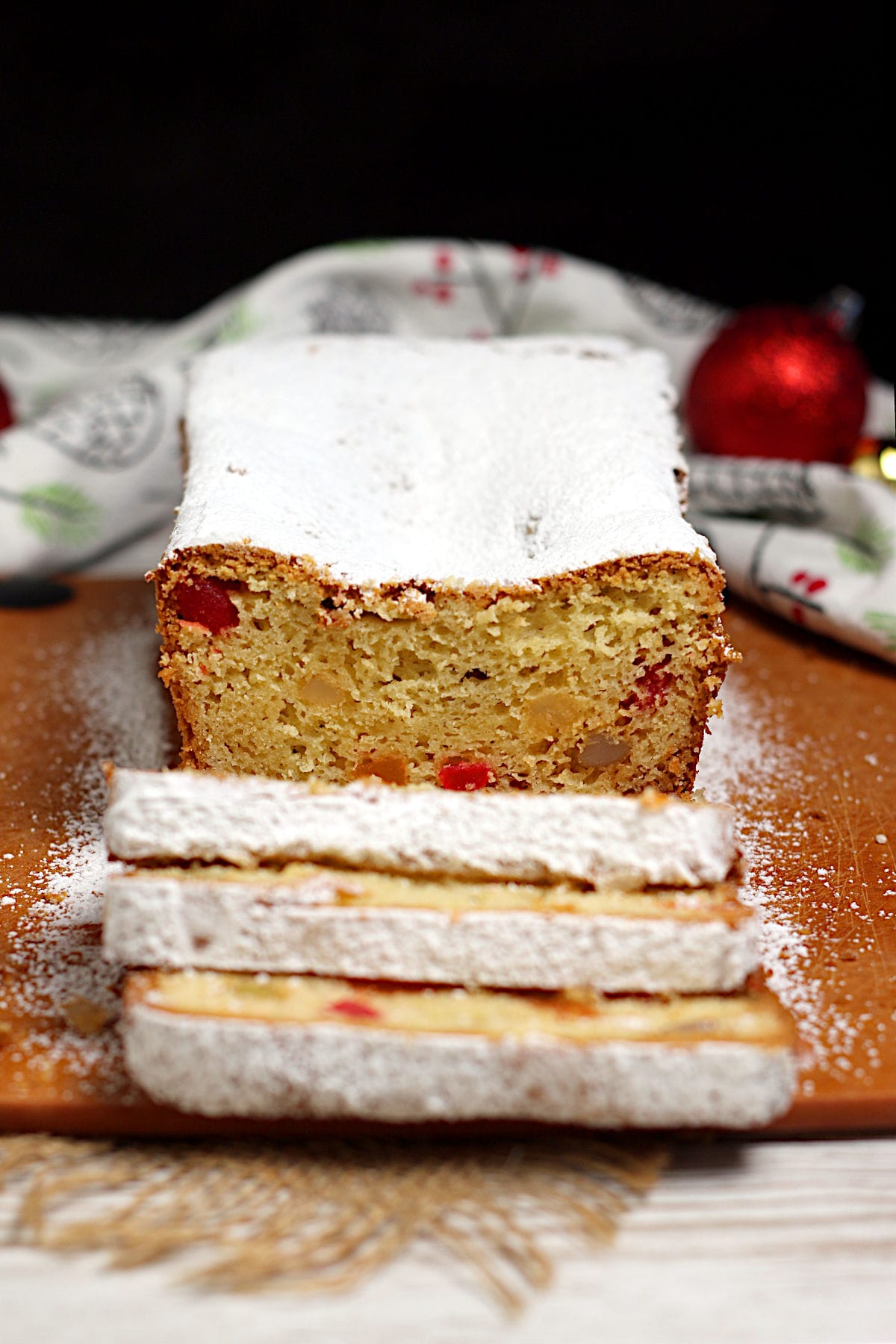
Scrape the batter into an 8.5×4.5″ (1-pound) loaf pan that has been greased, and the bottom lined with parchment paper. Smooth the batter into the corners of the pan.
Place the pan on the center rack of a 350°F oven, and bake until the cake is set and golden brown on the top, about 65-70 minutes. A toothpick inserted into the center of the cake should come out with a few crumbs clinging to it. Note that the center of the cake may sink upon cooling.
Let the cake cool in the pan on a wire rack for at least an hour before removing it from the pan. To remove easily, run a paring knife or offset spatula around the edges of the pan to loosen it.
If desired, sift powdered sugar over the top of the cake before serving it, or make a simple glaze with powdered sugar and liquid (water, milk, or cream), and a touch of vanilla.
Cut the cake into slices and serve. Store any leftovers in an airtight container or zipper bag at room temperature for up to two days, or in the freezer for an extended period.
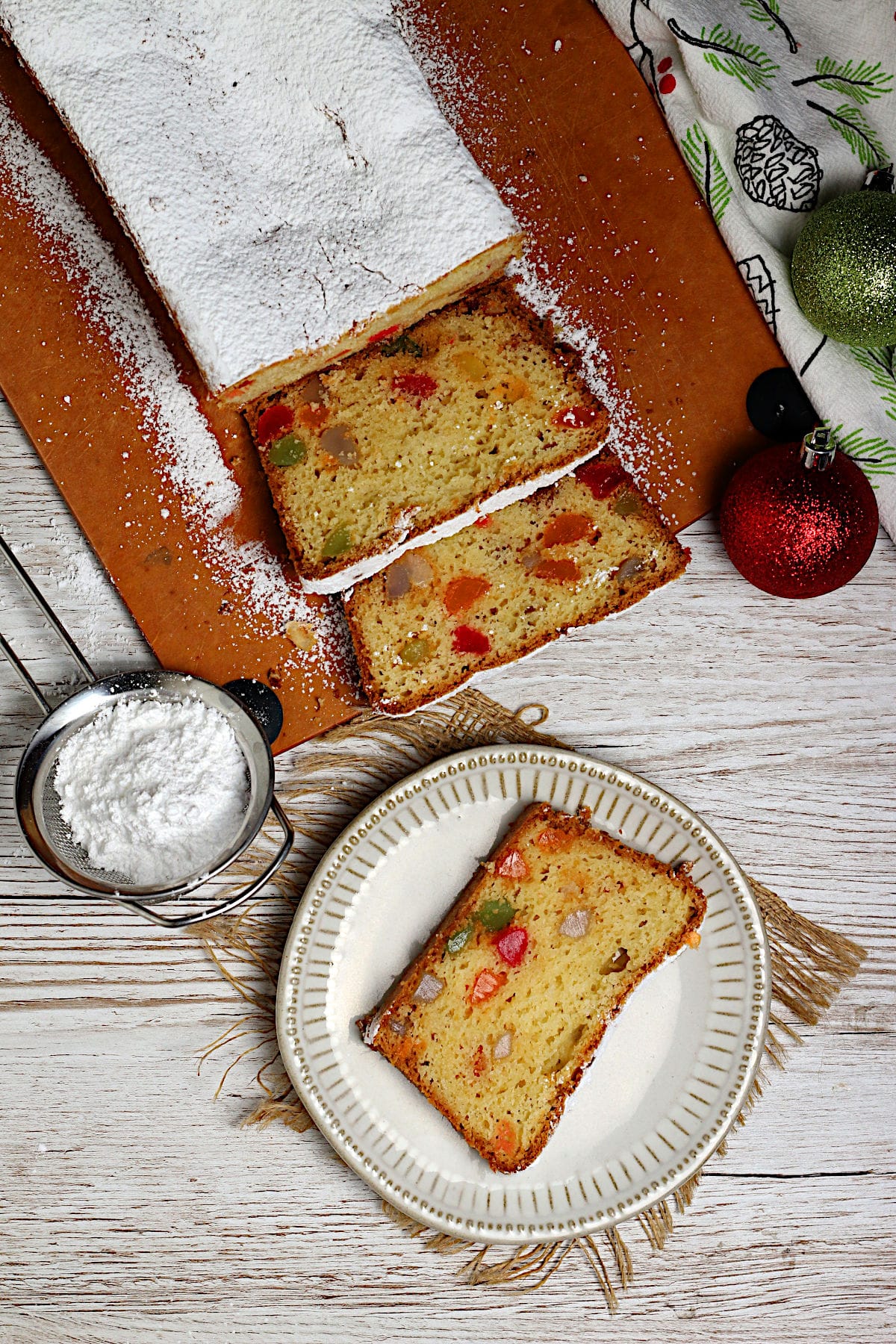
Gumdrop Loaf Cake FAQ’s
Why did my loaf cake sink in the middle?
Loaf cakes commonly sink in the middle, even if you do everything right while making it. This is simply due to the dimensions of the pan. The high sides cause the edges of the cake to cook more quickly than the center, which can sink upon removing the pan from the oven.
However, there are some steps you can take to reduce the likelihood and severity of the sinking.
1. Don’t open the oven door during cooking. The blast of cool air before the cake is done cooking can cause it to sink.
2. Don’t check the cake for doneness before you really think it’s done. Make sure to wait until at least the earliest time in the cooking range, and you see that the top of the cake is well-browned.
3. Make sure to use a metal loaf pan, not a glass pan. In fact, I recommend using metal pans for most baking recipes, since glass doesn’t transfer heat very well, and results in longer cooking times (or undercooked baked goods).
If your cake does sink, I assure you it will still taste great (mine did). If appearance is important, you can disguise the sink by topping the cake with powdered sugar or a simple glaze.
Can I use a different pan to make my gumdrop cake?
If you want to avoid the potential sinking problem with a loaf pan, you can make this cake in an 8-inch round pan without making any changes to the recipe. Note that the cake will cook more quickly because the batter is spread more thinly. I would recommend checking the cake after 30-35 minutes.
Alternatively, you can double the recipe and use 10-inch bundt or springform pan to make this cake. This would be suitable for larger groups. The baking time should be roughly the same, or slightly longer. To prevent sticking in a bundt pan, brush the inside of the pan with a 1:1 mixture of neutral-flavored cooking oil and flour. One tablespoon of each will do the trick.
What kind of gumdrops should I use, and where can I find them?
The gumdrops traditionally used for these cake are similar to the Ganong AB gums, or Dare Juicee Gumdrops. These gumdrops are fruit-flavored (remove any that aren’t like mint or licorice ones), and need to be cut into smaller pieces before adding them to the cake.
For ease, you can use baking gums, which are much smaller and don’t need to be cut up. Find these in the baking aisle or Bulk Barn.
Avoid using spice-flavored gums, which seem to be common in the US. If you can’t find fruit-flavored gumdrops, use jujubes instead, and cut them into small pieces.
Make sure to use candies that are thickened with cornstarch (you will see it featured high on the list of ingredients), and not gelatin (eg. gummy bears or anything with a similar texture), as I believe those would melt into the cake batter during cooking.
Gumdrop Loaf Cake Ingredients

Want more Canadian-inspired holiday baking recipes?
Gumdrop Loaf Cake Nutrition Notes
The nutrition information in the recipe below is for one slice of cake if you cut the loaf into 12 slices. If you cut the cake into larger (fewer) or smaller (more) slices, the nutrition information will vary accordingly.
The nutrition information does not include any optional toppings, like powdered sugar or glaze.
Equipment
Ingredients
Instructions
- Prepare an 8.5×4.5" (one pound) loaf pan by greasing it and lining the bottom with parchment paper. Set aside. Move the oven rack to the middle position and heat the oven to 325°F.
- If you're using full-sized gumdrops or jujubes, prepare them by cutting them into small pieces (I cut each gumdrop into about 6 pieces). Toss the gumdrops (including baking gums) with 2 Tablespoons (15 g) all-purpose flour. Set aside.
- Whisk together 1 cup (120 g) all-purpose flour, ½ teaspoon (2 g) baking powder, ½ teaspoon (2 g) baking soda, and ½ teaspoon (3 g) salt in a medium bowl. Set aside.
- Add ½ cup (114 g) unsalted butter and ¾ cup (150 g) granulated sugar to the bowl of a stand mixer fitted with a paddle attachment (or to a large bowl). Cream the butter and sugar together on medium-high speed until well combined. Add 4 ounces (113 g) cream cheese and cream it into the butter-sugar mixture until light and fluffy. Scrape down the sides of the bowl.
- Add 2 large eggs, one at a time, beating the mixture until well-combined and scraping down the sides of the bowl after each addition. Add 1 Tablespoon (15 g) lemon juice and ½ teaspoon (2 g) vanilla and beat again until well combined.
- Add the flour mixture and mix on low speed until no loose flour remains. Increase the mixer speed to medium and mix for about 1 minute until completely combined.
- Fold the gumdrops, as well as any loose flour that remains with the gumdrops into the batter, mixing gently until no pockets of flour remain. Note that the batter will be quite thick.
- Spread the batter into the prepared loaf pan. Bake for 65-70 minutes, until the top is golden brown and a toothpick comes out with a few crumbs clinging to it. Avoid opening the oven during cooking, or checking the cake too early to prevent the loaf from sinking. Place the pan on a wire rack to cool completely before removing from the pan.
- To serve, sprinkle the cake with powdered sugar, or make a simple glaze if desired. Cut into slices. Store any leftovers in an airtight container or zipper bag at room temperature for up to 2 days, or in the freezer for an extended period of time.
Nutrition
Notes
Tried this recipe?
Please Consider Leaving a Review!


